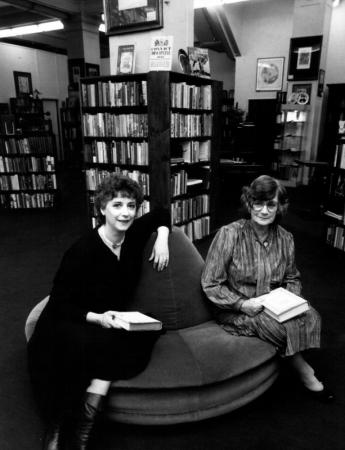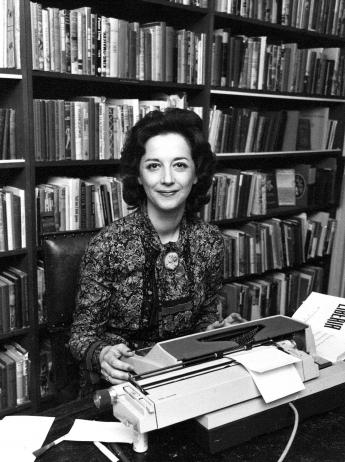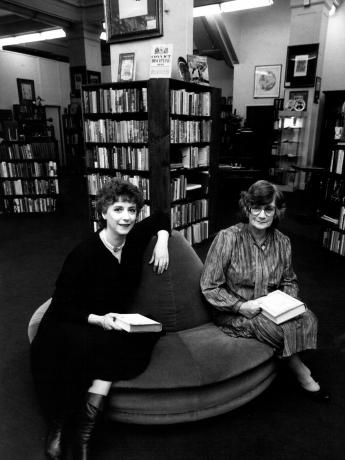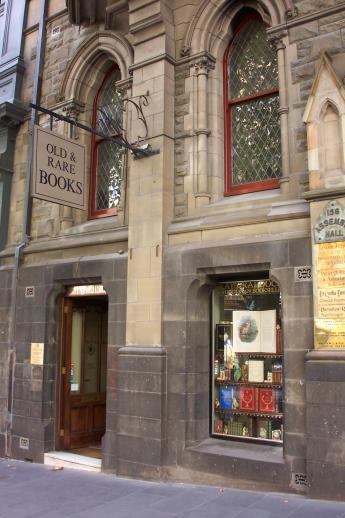News & Updates The Australian and New Zealand Association of Antiquarian Booksellers Kay Craddock - Antiquarian Bookseller Pty Ltd
Kay and Muriel Craddock - 50 Years in Business

Congratulations to Kay Craddock and her mother Muriel Craddock who are celebrating 50 years in the rare book trade.
"Immersed in the familiar hallmarks of "antique" and surrounded by up to 15,000 books, antiquarian bookseller Kay Craddock declares: "Books are good." The owner of the Collins Street landmark is well-positioned to know given her business is celebrating its 50th anniversary with one owner in the all-conquering digital age. Her store qualifies as an antiquity in its own right. So does her mother, Muriel Craddock, the 103-year-old matriarch who established the Essendon Treasure Chest on May 28, 1965, with her husband, Les ..." (The Age Newspaper)
28 May 1965 marked the beginning of an amazing career of two remarkable women. Les Craddock died in August 1965, leaving mother and daugther in a partnership that remains to this day. In 1967 Muriel and Kay Craddock opened their first city shop at 569 Bourke Street, 23 years later they moved to their current premises in the Neo Gothic Assembly Hall Building at 156 Collins Street, situated in the heart of Melbourne.
The beautiful salon style shop is a meeting point for booklovers and has a worldwide reputation. When The Australian and New Zealand Association of Antiquarian Booksellers (ANZAAB) was formed in 1977, Kay and Muriel were among the foundation members. Kay served as the third ANZAAB President (1987-1991), her mother Muriel was made ANZAAB's third Life Member on the occasion of her 90th birthday in April 2002. Another milestone: In 1996 Kay Craddock was the first bookseller from the Southern Hemisphere who was elected to the committee of the International League of Antiquarian Booksellers (ILAB), and from 2000 to 2002 she was the first female President in the history of ILAB.
The bookshop at Assembly Hall Building "is where bibliophile Barry Humphries appears at the front doorstep whenever he visits his home town, announcing theatrically: 'I'm back!' This is where a 1472 Bible, printed by Gutenberg apprentice Peter Schoeffer, was once sold for $ 200,000 to the Melbourne University library", a newspaper wrote in an article about Muriel Craddock in 2009.
And this is, where once during the 1980s two American booksellers grimly fought for the best copies from the famous Hamilton collection of 20th century literature - and finally became best friends. The brilliant story is published as chapter 19 in "Rare", an excellent book by Stuart Kells about the history of antiquarian bookselling in Australia in the second half of the 20th century through the lens of the personal and business lives of Kay and Muriel Craddock.
Where are they coming from?
Alex Hamilton was a municipal rates collector of modest means who devoted his bachelor life to music and modern literature. In a Ballarat miners cottage he amassed some 30,000 books.
Hamilton died in 1981, aged in his eighties. A relative who lived in Canberra approached the bookseller Barbara Burdon to discover how the collection might best be assessed. On Barbaras recommendation, the estate invited Melbourne booksellers Kay and Muriel Craddock to advise on probate and the books immediate safe storage.
Kay was driven to Ballarat by Alexs niece, Mary, with no conception of what she would find at her destination. The weatherboard cottage was lined with shelves that were filled with books. In the middle of each room were more books piled waist-high in tidy blocks. Visitors to Hamiltons home remarked that it was the books, and not the joists, boards and hardwood beams, that held the house up.
Hamilton had had a lady friend, whom he visited for dinner every Saturday evening, but he always left their dates by 9pm so as to be home in time to dust the books. Because of this obsessive care, almost every Hamilton book was in immaculate condition. The impact of walking into his cottage was like walking into Margareta Webbers famous bookshop after a sixty-year timewarp.
Kay felt the purchase was beyond her firm, both in its size and its likely price. Nevertheless, Mary agreed that Kay should take away and study Hamiltons index to the collection to establish probate and to possibly make an offer to purchase. The catalogue index was a complete listing, typed on small note-paper, simply of the author and title of each book, making it impossible to know which items were first editions. But Kay had seen enough examples during her visit to the cottage to know that most of the books were firsts in good order.
Nevertheless, researching the market value of the library was difficult, particularly without the books to hand. After probate was established, the negotiations for a possible purchase lasted seven months. Kay and Muriel ultimately made an offer, gambling with a bank loan that was large enough to ruin them, and a pantechnicon brought to Kays East St Kilda home 147 tea chests filled with Hamiltons books.
The gamble paid off. Ninety per cent of the books had been purchased when first published. Hamiltons avant-garde and farsighted instincts were astounding. Many important authors were represented, in books of unusually fine condition. In Muriels words, every book in the collection was a winner.
The Craddocks first offering from the Hamilton estate was in their Catalogue no. 86 (September 1982). The catalogue was entitled Twentieth Century Australian & New Zealand Literature, and included a note: Attention is drawn to the fact that items in this catalogue are in particularly fine [i.e. Collectors] condition.
Catalogue 87 (November 1982) featured a further 454 items of twentieth century literature from the collection. There were five Samuel Becketts: Endgame; his Three Novels Trilogy; Happy Days; How It Is; and a fine copy of the first English edition of Becketts novel Murphy (Routledge, 1938) in an equally fine dust wrapper (item no. 39). To catalogue Murphy, Kay needed to set a price, but information about the market value was scant. The book appeared only once in the available book auction guides, at a modest price. Using this as the basis for a considered guess, Kay priced the book at $95. The catalogue was despatched, but no Australian collector or bookseller ordered the book. When the catalogue reached a select list of booksellers in Britain and America, hell broke loose. The firm was besieged by orders from overseas dealers. Tom Goldwasser of San Franciscos Serendipity Books was the lucky one who bought the Murphy: his relative proximity to Melbourne gave him a postal advantage over his rivals from Britain and from Americas east coast.
A short while later, the Craddock Murphy was sold for 3500. It made the firms name known to a far wider audience than offering it for its true value could ever have achieved. Catalogue 87 became internationally famous, and demonstrated spectacularly that bargains can be found in booksellers catalogues. The Hamilton Murphy is now on offer for 62,500.
The Hamilton collections effect on dealers was narcotic. Kay had sent Catalogue 87 to several American booksellers. After his initial order and an ensuing telephone conversation with Kay, Tom Goldwasser telephoned again to say that he was now coming to Melbourne to see the Hamilton books. He said he was happy to see the uncatalogued books before they were priced, and asked if there were any William Faulkner titles, and if he could have first right of refusal on them if there were. Maurice Maurie Neville from Santa Barbara telephoned on the same day as Tom, wanting to buy the whole collection and upset that Tom was coming. Maurie, who was known to Kay and Muriel from an earlier visit he made to Melbourne, asked what else was in the collection. Most of the remaining books were only recently unpacked and not yet priced. The answer to Maurie was a genuine I dont know. After some discussion, Kay offered Maurie first refusal on any proof copies in the collection. Now Maurie and Tom were both coming, uninvited, and it seemed to the Craddocks that the two booksellers shared a deadly enmity.
Greg Young, a partner in Readings bookstore, was friendly with both west coast booksellers as well as with the Craddocks. In Melbourne he arranged accommodation for the visitors at a motel near his house. Kay thought a nice way to lift spirits would be to take the Americans out to dinner. Greg telephoned that evening and said he had a problem he was ready to come to dinner but there had been World War III at his home, and now the two booksellers were not speaking. He felt there was no way they were going to break the tension. Kay said firmly that there was a way that he must tell them they are not in Melbourne on Kays invitation, that the books are in her private home and not yet in stock, and that Kay would determine whether they saw the books or not.
The message was clear if you cannot behave, you will go home empty handed. Kay took some wine to the BYO restaurant on Chapel Street. The wine, mixed with the thought of the Hamilton collection, did its magic. The tension was broken. Kay said there were 30,000 books and that, if the visitors could not be happy with those, something was terribly wrong.
The plan of attack was agreed. Tom had first right on the Faulkner items, Maurie on the proof copies. For the rest, one bookseller would start at the beginning of the alphabet, the other at the end. Kay remembers Tom as a vacuum cleaner who bought great sweeps of genres all the gay and lesbian literature, all the black writing, and many authors Kay did not know. Maurie bought more cautiously about a third as much as Tom but he bought well. The drama had a Hollywood ending: looking over the books together left Maurie and Tom the best of friends.
A New York bookseller telephoned Kay in excitement he had received Catalogue 87 and it contained books he had never before seen in dust wrappers. For months it was a closely held secret overseas as to who and where Kay was, and where these fabulous books were coming from. Those in the know were careful not to say anything but some people did find out. The Hamilton collection has since attained mythic status, for its richness and the books condition. On the strength of the collection, Kay established a worldwide name for twentieth-century literature.
Catalogue 95 (September 1983) featured 168 illustrations of dust wrappers from the Hamilton collection. This and the earlier catalogues are an important documentary record of the collection that was a step-change in Kay and Muriels bookselling, one that divided the shop into pre- and post-Hamilton eras. Before Hamilton, the partners were somewhat less strict about dust wrappers and other aspects of completeness and condition. Now, they withdrew all stock that was not up to Hamilton standard. Selling the rejects cheaply to a general secondhand bookseller, they did not look back. (Copyright Stuart Kells 2011)
Rare. A Life Among Antiquarian Books. By Stuart Kells
Foreword by Geoffrey Blainey. Folio, Sydney, 2011. Pp. [viii] + 312 (last blank), text illustrations (some full page), pictorial endpapers, index; qr. black cloth, spine lettered in gilt, pictorial papered boards, upper board lettered and decorated in gilt and white. AU $ 65,-
The excerpt and pictures from "Rare" are published on ILAB.org by permission of Kay Craddock and Stuart Kells. Thank you very much.



